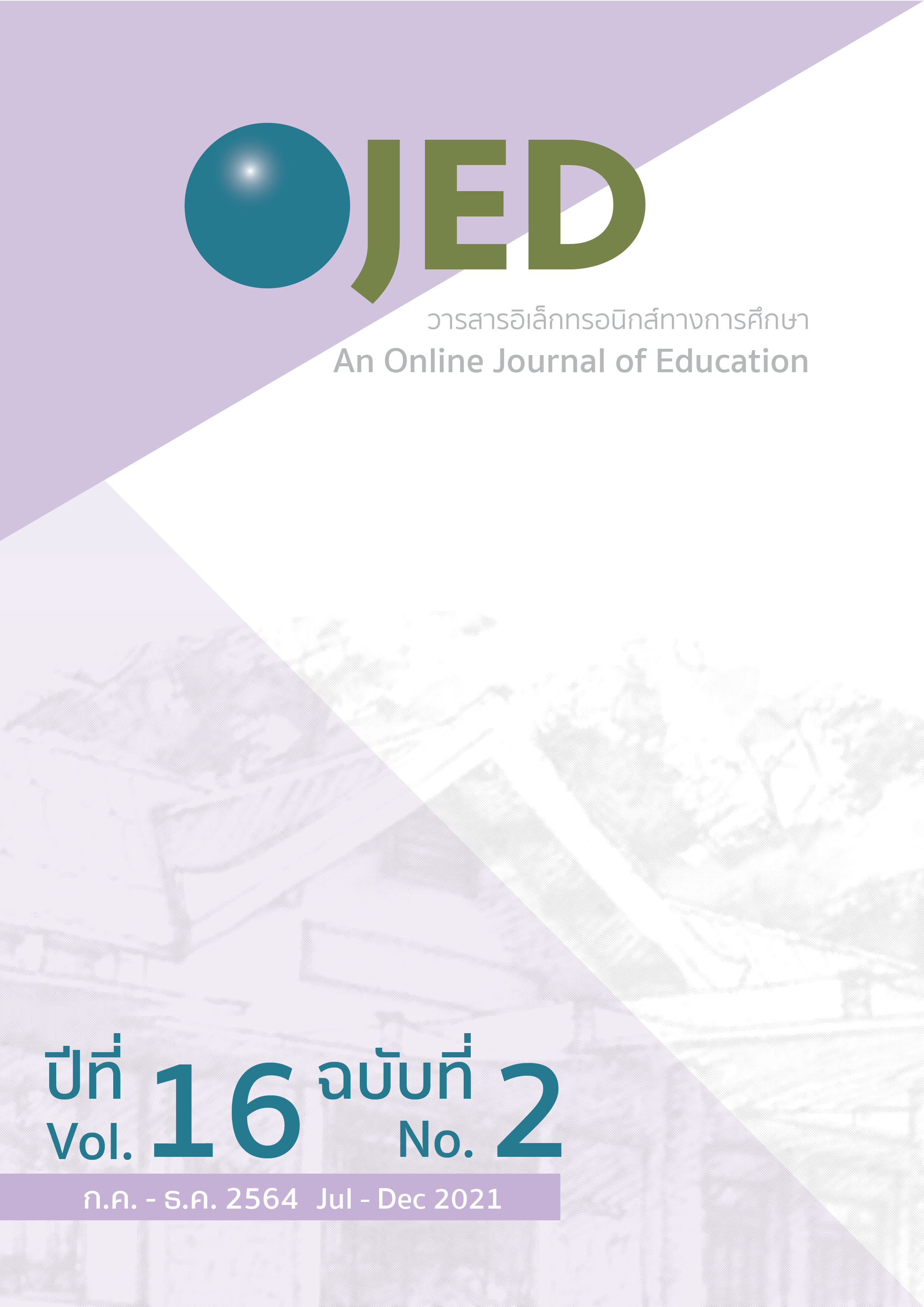การพัฒนาบทเรียนออนไลน์ตามแนวคิดการเรียนรู้ตามสถานการณ์และวิธีสอนอีเอสเอเพื่อเสริมสร้างความสามารถในการพูดภาษาอังกฤษของพนักงานมหาวิทยาลัย
คำสำคัญ:
ความสามารถในการพูดภาษาอังกฤษ, แนวคิดการเรียนรู้ตามสถานการณ์, บทเรียนออนไลน์, วิธีสอนอีเอสเอบทคัดย่อ
ภาษาอังกฤษเป็นภาษาสากลที่ใช้เป็นสื่อกลางเพื่อการสื่อสารในระดับอุดมศึกษาโดยเฉพาะหลักสูตรนานาชาติ ซึ่งพนักงานมหาวิทยาลัยจะต้องใช้ภาษาอังกฤษในการสื่อสารกับคณาจารย์ นักศึกษาต่างชาติ และมหาวิทยาลัยคู่สัญญาได้ การศึกษาครั้งนี้มีวัตถุประสงค์เพื่อ (1) ตรวจสอบประสิทธิภาพของบทเรียนออนไลน์ตามแนวคิดการเรียนรู้ตามสถานการณ์ (situated learning) และวิธีสอนอีเอสเอ (ESA method) เพื่อเสริมสร้างความสามารถในการพูดภาษาอังกฤษของพนักงานมหาวิทยาลัย และ (2) ศึกษาทัศนคติตของผู้เรียนต่อบทเรียนดังกล่าว ขอบเขตการศึกษาในครั้งนี้ใช้ประชากรตัวอย่างเป็นพนักงานมหาวิทยาลัย โดยกลุ่มตัวอย่างประกอบด้วยพนักงานมหาวิทยาลัยจำนวน 20 คน โดยเลือกวิธีการสุ่มตัวอย่างตามความสะดวก ผลการศึกษาพบว่าความสามารถในการสื่อสารของพนักงานในมหาวิทยาลัยเพิ่มขึ้นอย่างมีนัยสําคัญทางสถิติที่ระดับ 0.05 หลังจากการเรียนออนไลน์ที่ใช้วิธีการสอนร่วมกันทั้งสองวิธีตรวจสอบได้จากคะแนนของการทดสอบหลังเรียนที่สูงขึ้น นอกจากนี้ยังส่งผลต่อทัศนคติทางบวกของผู้เรียนต่อวิธีการสอนร่วมกันทั้งสองวิธี ดังนั้นบทเรียนออนไลน์ที่ใช้การสอนร่วมกันทั้งสองวิธีนี้เป็นประโยชน์ต่อพนักงานมหาวิทยาลัยตามผลการวิจัยที่มีการพัฒนากระบวนการเรียนรู้ของผู้เรียนและทัศนคติที่ดีต่อบทเรียนออนไลน์
References
Abrams, Z. I. (2003). The effect of synchronous and asynchronous CMC on oral performance in German. The Modern Language Journal, 87(2), 157-167.
Alharbi, A. S., & Alfadda, H. A. (2020). The Attitudes of Saudi Intermediate Students towards English Speaking Tasks in Flipped Learning via an Online Learning Community. Studies in English Language Teaching, 8(3). https://doi.org/https://doi.org/10.22158/selt.v8n3p37
Anthony, L. (2018). Introducing English for specific purposes. Routledge.
Arifani, D. N., Setiadi, R., & Darmawangsa, D. (2020). Effect and Students’ Perception of the ESA (Engage, Study, Activate) Teaching Method Implementation in French Writing Class. 3rd International Conference on Language, Literature, Culture, and Education (ICOLLITE 2019),
Bangkom, K., & Sukavatee, P. (2021). Effects of Oracy Building Instruction via Blended-Learning Environment on Thai Students' Metacognitive Awareness and Oracy Skills. LEARN Journal: Language Education and Acquisition Research Network, 14(1), 240-293.
Brown, C. A. (2017). Understanding the out-of-class English Learning Choices of Students in Taiwan. ASIAN TEFL, 2(1), 2017.
Brown, J. S., Collins, A., & Duguid, P. (1989). Situated cognition and the culture of learning. Educational researcher, 18(1), 32-42.
Crosling, G., & Ward, I. (2002). Oral communication: The workplace needs and uses of business graduate employees. English for Specific Purposes, 21(1), 41-57.
Crystal, D. (2012). English as a global language. Cambridge university press.
Fithria, M., & Ratmanida, R. (2019). Using ESA (Engage, Study, Activate) Method for Improving Students’ Speaking Ability at Junior High School. Journal of English Language Teaching, 8(1), 160-166.
Harmer, J. (2007). How to teach English: new edition. Harlow: Pearson Education Limited.
Ilinawati, I. (2018). Applying ESA (Engage, Study, Activate) Strategy to Improve Students’ Speaking Ability. VOX EDUKASI: Jurnal Ilmiah Ilmu Pendidikan, 9(1), 28-40.
Kasbi, S., & Shirvan, M. E. (2017). Ecological understanding of foreign language speaking anxiety: emerging patterns and dynamic systems. Asian-Pacific Journal of Second and Foreign Language Education, 2(1), 1-20.
Khoshsima, H., & Shokri, H. (2016). The effects of ESA elements on speaking ability of intermediate EFL learners: A task-based approach. Theory and Practice in Language Studies, 6(5), 1085-1095.
Lave, J., & Wenger, E. (1991). Situated learning: Legitimate peripheral participation. Cambridge university press.
Levy, M. (2009). Technologies in use for second language learning. The Modern Language Journal, 93, 769-782.
Mansy, M. F. A. (2018). Enhancing EFL Listening Comprehension Skills via a Blended Learning Based Program for Prep Stage Students. Journal of Faculty of Education, Benha University, 29(116), 1-21.
Nguyen, V., & Stracke, E. (2020). Learning experiences in and outside class by successful Vietnamese tertiary students studying English as a foreign language. Innovation in Language Learning and Teaching, 1-13.
Nickerson, C. (2013). 23 English for Specific Purposes and English as a Lingua Franca. The handbook of English for specific purposes, 445.
Özüdogru, M., & Özüdogru, F. (2017). The Effect of Situated Learning on Students Vocational English Learning. Universal Journal of Educational Research, 5(11), 2037-2044.
Pradaphon, K.-O. (2018). English For Oral Transactional Communication: A Case Study Of Financial Office Personnel Assumption University Thailand. วารสาร สถาบัน เทคโนโลยี แห่ง สุวรรณภูมิ, 3(1), 104-114.
Qin, H. (2013). Classroom Teaching Design for College English Listening and Speaking Course Based upon ESA Theory. Journal of Zhejiang International Studies University(5), 10.
Rahman, A. W. (2017). How good EFL learners decrease their foreign language anxiety: A solution for the EFL students with high anxiousness. Ethical Lingua: Journal of Language Teaching and Literature, 4(2), 127-138.
Rahmat, A. (2019). Enriching the Students Vocabulary Mastery in Speaking through Engage, Study, Activate Method. Metathesis: Journal of English Language, Literature, and Teaching, 3(1), 92-110.
Romaña Correa, Y. (2015). Skype™ conference calls: A way to promote speaking skills in the teaching and learning of English. Profile Issues in TeachersProfessional Development, 17(1), 143-156.
Rose, H., & McKinley, J. (2018). Japan’s English-medium instruction initiatives and the globalization of higher education. Higher Education, 75(1), 111-129.
Shapiro, H. B., Lee, C. H., Roth, N. E. W., Li, K., Çetinkaya-Rundel, M., & Canelas, D. A. (2017). Understanding the massive open online course (MOOC) student experience: An examination of attitudes, motivations, and barriers. Computers & Education, 110, 35-50.
Shokri, H. (2017). Investigating the Effect of Harmer’s ESA Elements on Reading Comprehension of Iranian EFL learners: A Task-based Approach. International Journal of English Language & Translation Studies, 5, 48-60.
Stein, D. (1998). Situated learning in adult education. on Adult, Career, and Vocational Education, Center on Education and Training for Employment, College of Education, the Ohio State University.
Sun, Y.-C., & Yang, F.-Y. (2015). I help, therefore, I learn: service learning on Web 2.0 in an EFL speaking class. Computer Assisted Language Learning, 28(3), 202-219.
Sung, Y.-T., Chang, K.-E., & Yang, J.-M. (2015). How effective are mobile devices for language learning? A meta-analysis. Educational research review, 16, 68-84.
Tangjitnusorn, K., & Sukavatee, P. (2016). The effects of community-based instruction using Hybrid learning on English oral communication for tourism industry of undergraduate students. Journal of Education Naresuan University, 18(4), 14-28.
Uz Bilgin, C., & Tokel, S. T. (2019). Facilitating contextual vocabulary learning in a mobile-supported situated learning environment. Journal of Educational Computing Research, 57(4), 930-953.
Wang, M.-j. (2010). Online collaboration and offline interaction between students using asynchronous tools in blended learning. Australasian Journal of Educational Technology, 26(6).
Wang, Y. S., Wu, M. C., & Wang, H. Y. (2009). Investigating the determinants and age and gender differences in the acceptance of mobile learning. British journal of educational technology, 40(1), 92-118.
Yang, Y.-F. (2011). Engaging students in an online situated language learning environment. Computer Assisted Language Learning, 24(2), 181-198.



